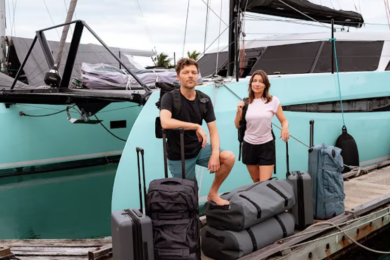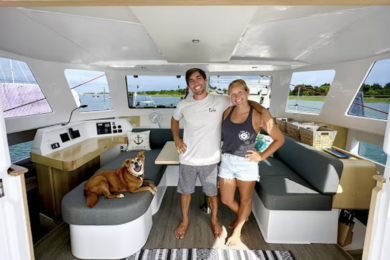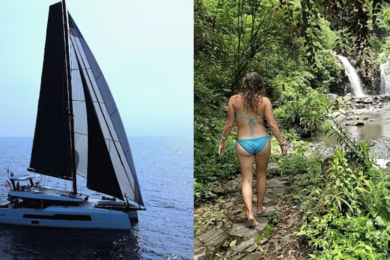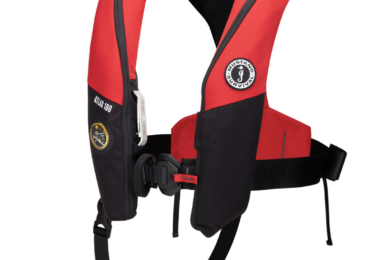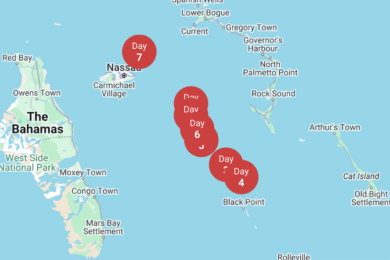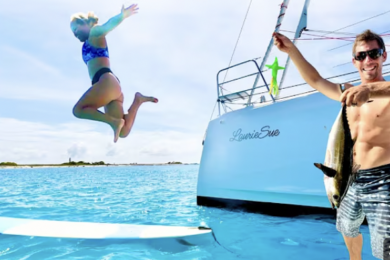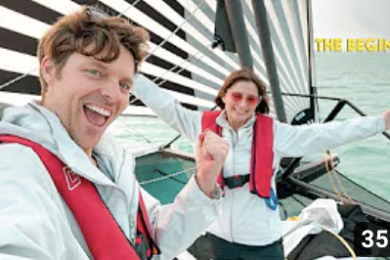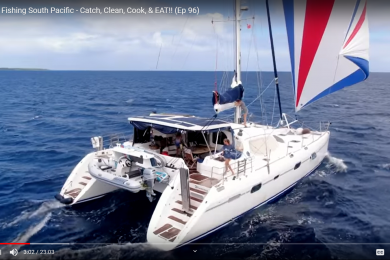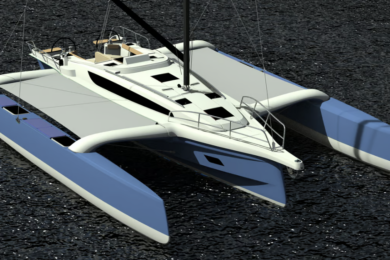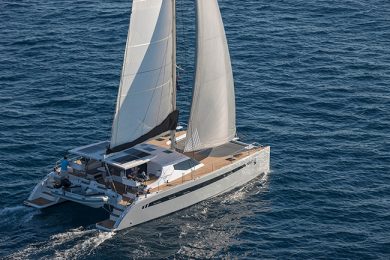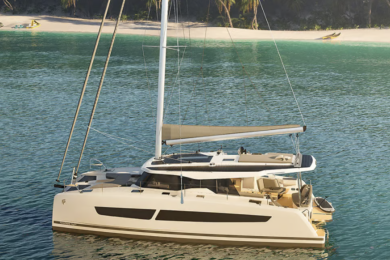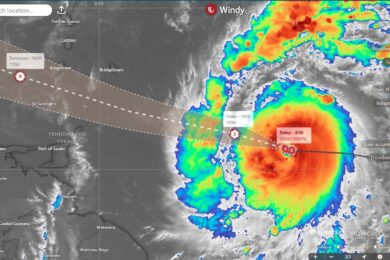 BWS publisher George Day finds the Nexus 600 to combine great bluewater passagemaking capabilities with practical and luxurious accommodations.
BWS publisher George Day finds the Nexus 600 to combine great bluewater passagemaking capabilities with practical and luxurious accommodations.
I first got to know the Nexus 600 when I visited the plant in St. Francis Bay, South Africa in the fall of 2010, but I did not have an opportunity to go for a sail while there. Nevertheless, my first impression was most favorable and I came away feeling that here was a vessel that really works well and adds some fresh thinking to the business of designing and building a large cruising cat.
A simple concept lies behind the evolution of the Nexus 600. Mark Paarman was looking for a boat that he could take to the best surfing regions of the world with his friends and some paying guests. St. Francis Bay, we learned, is right next to Jeffries Bay, home to beaches that are considered to be in the top 10 surf spots in the world. But the waves of Indonesia and the south Pacific beckoned, and a 60-foot cat seemed like the best way to get there while avoiding the crowds that throng to surf resorts.
As Mark was developing the design, he was joined by John Herrick, an avid fisherman who was looking for an oceangoing expedition cat for excursions to the world’s remotest fishing grounds. Mark and John joined forces to become the founding partners of Nexus Catamarans, and Mark’s brothers, Roger and Jonathan, were recruited to join the company as general manager and project manager respectively. The first boat was launched in 2009 and two more have followed.
DESIGN
Because the 600 is a long-range cruiser that will often have six or eight people aboard, the hulls have been designed to carry the weight of fuel, water and supplies that expeditions require. The 600 has tanks for 634 gallons of diesel and 585 gallons of water. The hulls have plumb bows and are fairly full all the way fore and aft. The engines and all tanks have been positioned to keep weight out of the ends, so as fuel and water are depleted, the trim does not change. The hull sections actually have some flare, so buoyancy increases as the hulls are loaded with water and fuel.
 In keeping with the mandate to build a simple boat, fixed keels are used instead of daggerboards. For an ocean sailing boat that will rarely be sailing upwind for long, this makes sense. The bridgedeck between the hulls is 40 inches off the water, a height that has proven over the years to greatly reduce wave slapping as the boat sails through chop.
In keeping with the mandate to build a simple boat, fixed keels are used instead of daggerboards. For an ocean sailing boat that will rarely be sailing upwind for long, this makes sense. The bridgedeck between the hulls is 40 inches off the water, a height that has proven over the years to greatly reduce wave slapping as the boat sails through chop.
Also, specifying twin 110-horsepower diesels may seem like overkill, but the extra horsepower provides high capacity redundancy should one of the engines fail. And knowing that there will come a day when one or both of the engines will need to come out of the boat, a removable hatch and lifting mechanism has been built into the cockpit molding and the hard bimini top.
There is almost no wood on the boat. On deck, all of the trim and handholds are stainless steel. In the interior, all doors and drawer fronts are built with bamboo laminate, which is a highly renewable resource and very durable. The floor throughout is a gray-flecked laminate that is easy to clean and looks very modern. In a pinch, you could remove the cushions from the interior and clean it with a hose and brush.
But that is not to say that the boat is at all industrial looking. In fact, the white-molded parts, the gray floor and trim, the stainless steel detailing and handholds, and the bamboo panels and doors all combine to create a very modern and elegant interior.
On deck, the rig and deck layout are designed to be handled by one person. All sheets and control lines run through deck organizers to the winches near the raised helm station on the starboard side of the cockpit. Electric winches make raising the big mainsail and trimming the genoa sheets simplicity itself. And, with the main sheet and traveler control lines always at hand, the helmsman can dump the mainsail if the boat ever feels overpowered by a wind gust.
The rig has been designed with a full battened main and a large working genoa. Plus, with the bowsprit deployed, you can fly a Code Zero headsail for power reaching or a full cut asymmetrical for running off.
Down below, the 600 has four double cabins and two single berths so it can accommodate up to 10 people. The after cabins are large double cabins with en suite heads. The engines are placed under the beds, so with the platforms raised, you have full access to them for routine maintenance and repairs. Great care has been taken to insulate these engine boxes.
The forward double cabins have raised berths that run athwartships. Because the parties sailing and cruising aboard the 600 may be guys surfing or fishing together, the forward doubles can be divided with bundling boards into two individual single berths.
 The 600 is conceived as a very sociable boat. The saloon is set up with a large galley that is integral to the living spaces where mates or couples can enjoy cooking and eating and reflecting on the day’s activities. The outside cockpit dinette will seat eight comfortably and the inside table will seat six. A large sliding window connects the galley to the cockpit and an island in the saloon provides a place to serve a buffet. The cockpit can be enclosed with large isinglass panels, so you could have a weatherproof living space that is vast enough for a wedding party.
The 600 is conceived as a very sociable boat. The saloon is set up with a large galley that is integral to the living spaces where mates or couples can enjoy cooking and eating and reflecting on the day’s activities. The outside cockpit dinette will seat eight comfortably and the inside table will seat six. A large sliding window connects the galley to the cockpit and an island in the saloon provides a place to serve a buffet. The cockpit can be enclosed with large isinglass panels, so you could have a weatherproof living space that is vast enough for a wedding party.
There is a lot to like in the way the Paarmans have gone about designing and building the Nexus 600. It is modern, very well thought through and capable of real expedition sailing without losing its manly sense of style.
SAIL TRIALS
Almost a year after first seeing the Nexus 600 in South Africa, I had the opportunity to sail hull number one on the Chesapeake Bay after the Annapolis sailboat show last fall. Roger Paarman and his wife were aboard and the boat was being run by a professional skipper and his wife.
They plucked me off a pier in downtown Annapolis and quickly motored into the bay, where we found a mild northwest breeze and a lot of other bigger cats out being sail-tested. This was going to be fun.
We hoisted the big full battened main and then fell off onto a broad reach and rolled out the genoa. At first, the 600 did not feel as though she was moving. The boat is so stable and at the helm you are so far off the water that the normal indications of speed are elusive until you glance at the speedo to see that that you are sailing at 8 knots in 10 knots of true wind.
We reached well out into the bay and passed one cruising cat after the next. We wondered if the other boats were being sailed poorly or if there was something wrong. But, in the end, we simply discovered that only the Gunboat 62 was going to sail faster than we could.
To rub it in a bit more, we rolled out the Code Zero and took off at a really good clip on a close reach. We were making our own wind now, so the 600 seemed to bring the apparent wind right forward and accelerate. We had a solid 9 knots of boat speed in a breeze that fluctuated between 10 and 12 true.
For the return sail we had a long haul to windward, so we started short tacking. Despite the big genoa, the boat was easy to tack and carried her way through the tacks without losing too much speed. We were able to tack in just about 90 degrees and were making a touch of leeway, but the speed was good and progress was very acceptable. I doubt we would have bothered had we not had the electric winches.
The Nexus 600 really handles well for a big catamaran. She motors very capably, and with twin engines is extremely handy around the docks. She sails better than most cruising cats and is truly easy to handle for a lone helmsman.
A fresh take on what a long-range cruising cat can be, the Nexus 600 will serve her crew well any and everywhere in the world, whether sailed by a couple, a family or expedition crews in search of big waves and big fish.
Nexus 600
LOA 60’0”
LWL 52’6”
Beam 28’6”
Draft 4’5”
Displ. 36,000 lbs.
Sail area 2,175 sq. ft
Fuel 634 gals
Water 585 gals.
NEXUS CATAMARANS
Tel: (042) 294 0321
Fax: (042) 294 1819
info@nexuscatamarans.com
www.nexuscatamarans.com

